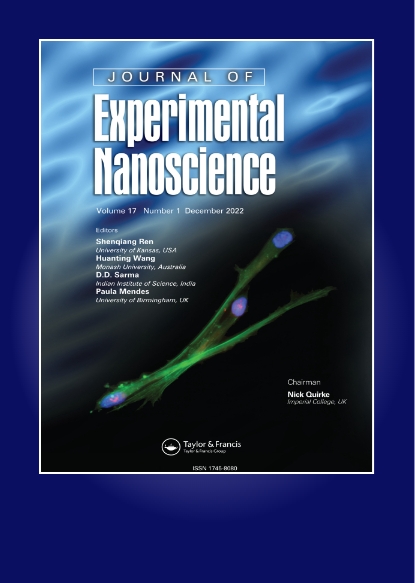金盏菊叶水提物绿色合成锡纳米颗粒抑制MCF7、Hs 319的抗乳腺癌作用T和MCF10细胞增殖
IF 2.6
4区 材料科学
Q2 CHEMISTRY, MULTIDISCIPLINARY
引用次数: 3
摘要
摘要本研究以金盏菊水提物为原料合成了绿色纳米锡。采用FE-SEM、XRD、FT-IR、EDS等技术对SnNPs@ C. officinalis进行表征。通过XRD分析得到了锡纳米粒子的晶粒尺寸为21.87 nm。FE-SEM图像显示SnNPs@ C. officinalis的形貌为球形,粒径范围为21.63 ~ 64.07。研究了生物合成SnNPs@ C. officinalis对乳腺癌细胞系的抗乳腺癌作用。SnNPs@ C. officinalis的抗乳腺癌特性可以显著去除MCF7, Hs 319。MTT法在时间和浓度依赖性上检测MCF10癌细胞。采用DPPH法测定SnNPs@ officinalis的抗氧化活性。根据IC50值,SnNPs@ C. officinalis的抗氧化活性最高。最近的纳米颗粒的抗乳腺癌作用似乎是由于它们的抗氧化作用。本文章由计算机程序翻译,如有差异,请以英文原文为准。
Anti-breast carcinoma effects of green synthesized tin nanoparticles from Calendula officinalis leaf aqueous extract inhibits MCF7, Hs 319.T, and MCF10 cells proliferation
Abstract In this study, tin nanoparticles were green synthesized using the aqueous extract of Calendula officinalis. Different techniques such as FE-SEM, XRD, FT-IR, and EDS analysis were used to characterize SnNPs@ C. officinalis. A 21.87 nm was obtained for the crystal size of the tin nanoparticles using XRD analysis. The FE-SEM images show a spherical morphology for SnNPs@ C. officinalis with a range size of 21.63–64.07 for the synthetic nanoparticles. The anti-breast cancer effects of biologically synthesized SnNPs@ C. officinalis against breast cancer cell lines were assessed. The anti-breast cancer properties of the SnNPs@ C. officinalis could significantly remove the MCF7, Hs 319.T, and MCF10 cancer cell lines in a time and concentration-dependent manner by MTT assay. The antioxidant activity of SnNPs@ C. officinalis was determined by the DPPH method. The SnNPs@ C. officinalis showed the highest antioxidant activity according to the IC50 value. It seems the anti-human breast cancer effect of recent nanoparticles is due to their antioxidant effects.
求助全文
通过发布文献求助,成功后即可免费获取论文全文。
去求助
来源期刊

Journal of Experimental Nanoscience
工程技术-材料科学:综合
CiteScore
4.10
自引率
25.00%
发文量
39
审稿时长
6.5 months
期刊介绍:
Journal of Experimental Nanoscience, an international and multidisciplinary journal, provides a showcase for advances in the experimental sciences underlying nanotechnology and nanomaterials.
The journal exists to bring together the most significant papers making original contributions to nanoscience in a range of fields including biology and biochemistry, physics, chemistry, chemical, electrical and mechanical engineering, materials, pharmaceuticals and medicine. The aim is to provide a forum in which cross fertilization between application areas, methodologies, disciplines, as well as academic and industrial researchers can take place and new developments can be encouraged.
 求助内容:
求助内容: 应助结果提醒方式:
应助结果提醒方式:


